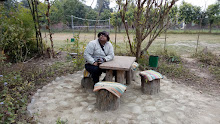Brassica campestris L.
Field Mustard !!
BOTANICAL NAME: Brassica campestris L.
FAMILY: Brassicaceae
SYNONYMS: Brassica rapa L. var. rapa, Brassica campestris L. ssp. rapifera (Metzger) Sinsk., Brassica campestris L. var. rapa (L.) Hartman, Brassica rapa L. ssp. campestris (L.) Clapham, Brassica rapa L. ssp. olifera DC., Brassica rapa L. ssp. sylvestris Janchen, Brassica rapa L. var. campestris (L.) W.D.J. Koch, Caulanthus sulfureus Payson, Brassica pe-tsai L. H. Bailey, Brassica pekinensis (Lour.) Rupr.
ORIGIN: Field mustard is native to Europe but has become naturalized throughout North America.
GENERAL DESCRIPTION: # Life cycle (annual/biennial/
# Growth habit & Regrowth type: Erect growth habit with stems up to 1 m tall.
# Invasive potential: Field mustard is an aggressive weed of fields and waste ground. It has be reported to be poisonous to livestock.
BOTANICAL NAME:# Inflorescence: The inflorescence is a raceme. The fruit is a silique 4-7 cm long, terete or nearly so having a beak up to 2 cm long. The siliques are on long pedicels up to 3 cm long. The valves are one-nerved with two delicate lateral nerves. Field mustard inflorescence image.
# Flower: The flowers are yellow with four petals.
# Seed: The seeds are minutely roughened, round or slightly compressed laterally, reddish-gray 1-2 mm in diameter.
# Stem: Field mustard has stems up to 1 m tall. They are glabrous or nearly so and commonly glaucous.
# Leaf: The basal leaves are petioled with lyrate-pinnatifid blades. The lower cauline leaves are similar to the basal leaves. The upper cauline leaves become oblong to lanceolate, entire to dentate, and are sessile to clasping.
# Leaves are petioled, +/- pinnatifid or lobed, 1-2 dm long; upper leaves, sessile, auriculate-clasping, lance-oblong, subentire, glabrous; pedicels spreading, 1-2 cm. long; sepals narrow-oblong,yellowish, 4-5 mm long; petals yellow, spatulate, 6-8 mm long; siliques not torulose, terete, 2-5 cm long, stout with a stout beak an additional 1-1.5 cm long.
SOURCES:>>http://
>>http://
>>http://onh.eugraph.com/
>>http://eol.org/pages/
>>http://www.uniprot.org/
BOTANICAL NAME: Brassica campestris L.
FAMILY: Brassicaceae
SYNONYMS: Brassica rapa L. var. rapa, Brassica campestris L. ssp. rapifera (Metzger) Sinsk., Brassica campestris L. var. rapa (L.) Hartman, Brassica rapa L. ssp. campestris (L.) Clapham, Brassica rapa L. ssp. olifera DC., Brassica rapa L. ssp. sylvestris Janchen, Brassica rapa L. var. campestris (L.) W.D.J. Koch, Caulanthus sulfureus Payson, Brassica pe-tsai L. H. Bailey, Brassica pekinensis (Lour.) Rupr.
ORIGIN: Field mustard is native to Europe but has become naturalized throughout North America.
GENERAL DESCRIPTION: # Life cycle (annual/biennial/
# Growth habit & Regrowth type: Erect growth habit with stems up to 1 m tall.
# Invasive potential: Field mustard is an aggressive weed of fields and waste ground. It has be reported to be poisonous to livestock.
BOTANICAL NAME:# Inflorescence: The inflorescence is a raceme. The fruit is a silique 4-7 cm long, terete or nearly so having a beak up to 2 cm long. The siliques are on long pedicels up to 3 cm long. The valves are one-nerved with two delicate lateral nerves. Field mustard inflorescence image.
# Flower: The flowers are yellow with four petals.
# Seed: The seeds are minutely roughened, round or slightly compressed laterally, reddish-gray 1-2 mm in diameter.
# Stem: Field mustard has stems up to 1 m tall. They are glabrous or nearly so and commonly glaucous.
# Leaf: The basal leaves are petioled with lyrate-pinnatifid blades. The lower cauline leaves are similar to the basal leaves. The upper cauline leaves become oblong to lanceolate, entire to dentate, and are sessile to clasping.
# Leaves are petioled, +/- pinnatifid or lobed, 1-2 dm long; upper leaves, sessile, auriculate-clasping, lance-oblong, subentire, glabrous; pedicels spreading, 1-2 cm. long; sepals narrow-oblong,yellowish, 4-5 mm long; petals yellow, spatulate, 6-8 mm long; siliques not torulose, terete, 2-5 cm long, stout with a stout beak an additional 1-1.5 cm long.
SOURCES:>>http://
>>http://
>>http://onh.eugraph.com/
>>http://eol.org/pages/
>>http://www.uniprot.org/





%5D+ban+tulsi.JPG)







